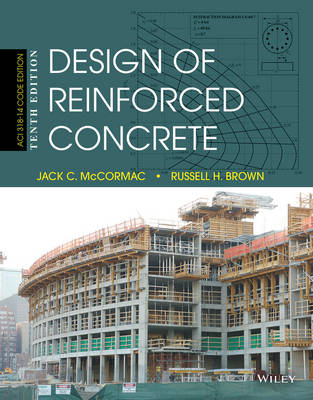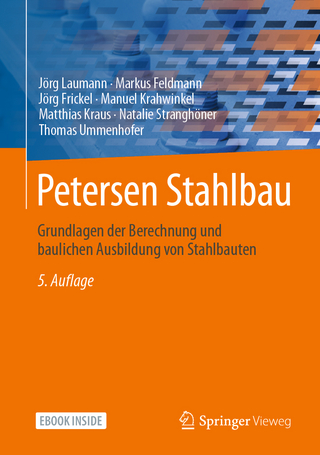
Design of Reinforced Concrete
John Wiley & Sons Inc (Verlag)
978-1-118-87910-8 (ISBN)
Jack C. McCormac is Alumni Distinguished Professor o Civil Engineering, Emeritus at Clemson University. He holds a BS in civil engineering from the Citadel, an MS in civil engineering from Massachusetts Institute of Technology, and a Doctor of Letters from Clemson University. His contributions to engineering education and the engineering profession have been recognized by many, including the American Society for Engineering Education, the American Institute of Steel Construction, and the American Concrete Institute. Professor McCormac was included in the International Who's Who in Engineering, and was named by the Engineering News-Record as one of the top 125 engineers or architects in the world in the last 125 years for his contributions to the construction industry. He was one of only two educators living in the world today to receive this honor. Professor McCormac belongs to the American Society of Civil Engineers and served as the principal civil engineering grader for the National Council of Examiners for Engineering and Surveying for many years.
Preface xv
1 Introduction 1
1.1 Concrete and Reinforced Concrete 1
1.2 Advantages of Reinforced Concrete as a Structural Material 1
1.3 Disadvantages of Reinforced Concrete as a Structural Material 2
1.4 Historical Background 3
1.5 Comparison of Reinforced Concrete and Structural Steel for Buildings and Bridges 5
1.6 Compatibility of Concrete and Steel 6
1.7 Design Codes 6
1.8 SI Units and Shaded Areas 7
1.9 Types of Portland Cement 7
1.10 Admixtures 9
1.11 Properties of Concrete 10
1.12 Aggregate 18
1.13 High–Strength Concretes 19
1.14 Fiber–Reinforced Concretes 20
1.15 Concrete Durability 21
1.16 Reinforcing Steel 22
1.17 Grades of Reinforcing Steel 24
1.18 SI Bar Sizes and Material Strengths 25
1.19 Corrosive Environments 26
1.20 Identifying Marks on Reinforcing Bars 26
1.21 Introduction to Loads 28
1.22 Dead Loads 28
1.23 Live Loads 29
1.24 Environmental Loads 30
1.25 Selection of Design Loads 32
1.26 Calculation Accuracy33
1.27 Impact of Computers on Reinforced Concrete Design 34
Problems 34
2 Flexural Analysis of Beams 35
2.1 Introduction 35
2.2 Cracking Moment 38
2.3 Elastic Stresses—Concrete Cracked 41
2.4 Ultimate or Nominal Flexural Moments 48
2.5 SI Example 51
2.6 Computer Examples 52
Problems 54
3 Strength Analysis of Beams According to ACI Code 65
3.1 Design Methods 65
3.2 Advantages of Strength Design 66
3.3 Structural Safety 66
3.4 Derivation of Beam Expressions 67
3.5 Strains in Flexural Members, 70
3.6 Balanced Sections, Tension–Controlled Sections, and Compression–Controlled or Brittle Sections 71
3.7 Strength Reduction or φ Factors 71
3.8 Minimum Percentage of Steel 74
3.9 Balanced Steel Percentage 75
3.10 Example Problems 76
3.11 Computer Examples 79
Problems 80
4 Design of Rectangular Beams and One–Way Slabs 82
4.1 Load Factors 82
4.2 Design of Rectangular Beams 85
4.3 Beam Design Examples 89
4.4 Miscellaneous Beam Considerations 95
4.5 Determining Steel Area When Beam Dimensions Are Predetermined 96
4.6 Bundled Bars 98
4.7 One–Way Slabs 99
4.8 Cantilever Beams and Continuous Beams 102
4.9 SI Example 103
4.10 Computer Example 105
Problems 106
5 Analysis and Design of T Beams and Doubly Reinforced Beams 112
5.1 T Beams 112
5.2 Analysis of T Beams 114
5.3 Another Method for Analyzing T Beams 118
5.4 Design of T Beams 120
5.5 Design of T Beams for Negative Moments 125
5.6 L–Shaped Beams 127
5.7 Compression Steel 127
5.8 Design of Doubly Reinforced Beams 132
5.9 SI Examples 136
5.10 Computer Examples, 138
Problems 143
6 Serviceability 154
6.1 Introduction 154
6.2 Importance of Deflections 154
6.3 Control of Deflections 155
6.4 Calculation of Deflections 157
6.5 Effective Moments of Inertia 158
6.6 Long–Term Deflections 160
6.7 Simple–Beam Deflections 162
6.8 Continuous–Beam Deflections 164
6.9 Types of Cracks 170
6.10 Control of Flexural Cracks 171
6.11 ACI Code Provisions Concerning Cracks 175
6.12 Miscellaneous Cracks 176
6.13 SI Example 176
6.14 Computer Example 177
Problems 179
7 Bond, Development Lengths, and Splices 184
7.1 Cutting Off or Bending Bars 184
7.2 Bond Stresses 187
7.3 Development Lengths for Tension Reinforcing 189
7.4 Development Lengths for Bundled Bars 197
7.5 Hooks 199
7.6 Development Lengths for Welded Wire Fabric in Tension 203
7.7 Development Lengths for Compression Bars 204
7.8 Critical Sections for Development Length 206
7.9 Effect of Combined Shear and Moment on Development Lengths 206
7.10 Effect of Shape of Moment Diagram on Development Lengths 207
7.11 Cutting Off or Bending Bars (Continued) 208
7.12 Bar Splices in Flexural Members 211
7.13 Tension Splices 213
7.14 Compression Splices 213
7.15 Headed and Mechanically Anchored Bars 214
7.16 SI Example 215
7.17 Computer Example 216
Problems 217
8 Shear and Diagonal Tension 223
8.1 Introduction 223
8.2 Shear Stresses in Concrete Beams 223
8.3 Lightweight Concrete 224
8.4 Shear Strength of Concrete 225
8.5 Shear Cracking of Reinforced Concrete Beams 226
8.6 Web Reinforcement 227
8.7 Behavior of Beams with Web Reinforcement 229
8.8 Design for Shear 231
8.9 ACI Code Requirements 232
8.10 Shear Design Example Problems 237
8.11 Economical Spacing of Stirrups 247
8.12 Shear Friction and Corbels 249
8.13 Shear Strength of Members Subjected to Axial Forces 251
8.14 Shear Design Provisions for Deep Beams 253
8.15 Introductory Comments on Torsion 254
8.16 SI Example 256
8.17 Computer Example 257
Problems 258
9 Introduction to Columns 263
9.1 General 263
9.2 Types of Columns 264
9.3 Axial Load Capacity of Columns 266
9.4 Failure of Tied and Spiral Columns 266
9.5 Code Requirements for Cast–in–Place Columns 269
9.6 Safety Provisions for Columns 271
9.7 Design Formulas 272
9.8 Comments on Economical Column Design 273
9.9 Design of Axially Loaded Columns 274
9.10 SI Example 277
9.11 Computer Example 278
Problems 279
10 Design of Short Columns Subject to Axial Load and Bending 281
10.1 Axial Load and Bending 281
10.2 The Plastic Centroid 282
10.3 Development of Interaction Diagrams 284
10.4 Use of Interaction Diagrams 290
10.5 Code Modifications of Column Interaction Diagrams 292
10.6 Design and Analysis of Eccentrically Loaded Columns Using Interaction Diagrams 294
10.7 Shear in Columns 301
10.8 Biaxial Bending 302
10.9 Design of Biaxially Loaded Columns 306
10.10 Continued Discussion of Capacity Reduction Factors, φ 309
10.11 Computer Example 311
Problems 312
11 Slender Columns 317
11.1 Introduction 317
11.2 Nonsway and Sway Frames 317
11.3 Slenderness Effects 318
11.4 Determining k Factors with Alignment Charts 321
11.5 Determining k Factors with Equations 322
11.6 First–Order Analyses Using Special Member Properties 323
11.7 Slender Columns in Nonsway and Sway Frames 324
11.8 ACI Code Treatments of Slenderness Effects 328
11.9 Magnification of Column Moments in Nonsway Frames 328
11.10 Magnification of Column Moments in Sway Frames 333
11.11 Analysis of Sway Frames 336
11.12 Computer Examples 342
Problems 344
12 Footings 347
12.1 Introduction 347
12.2 Types of Footings 347
12.3 Actual Soil Pressures 350
12.4 Allowable Soil Pressures 351
12.5 Design of Wall Footings 352
12.6 Design of Square Isolated Footings 357
12.7 Footings Supporting Round or Regular Polygon–Shaped Columns 364
12.8 Load Transfer from Columns to Footings 364
12.9 Rectangular Isolated Footings 369
12.10 Combined Footings 372
12.11 Footing Design for Equal Settlements 378
12.12 Footings Subjected to Axial Loads and Moments 380
12.13 Transfer of Horizontal Forces 382
12.14 Plain Concrete Footings 383
12.15 SI Example 386
12.16 Computer Examples 388
Problems 391
13 Retaining Walls 394
13.1 Introduction 394
13.2 Types of Retaining Walls 394
13.3 Drainage 397
13.4 Failures of Retaining Walls 398
13.5 Lateral Pressure on Retaining Walls 399
13.6 Footing Soil Pressures 404
13.7 Design of Semigravity Retaining Walls 405
13.8 Effect of Surcharge 408
13.9 Estimating the Sizes of Cantilever Retaining Walls 409
13.10 Design Procedure for Cantilever Retaining Walls 413
13.11 Cracks and Wall Joints 424
Problems 426
14 Continuous Reinforced Concrete Structures 431
14.1 Introduction 431
14.2 General Discussion of Analysis Methods 431
14.3 Qualitative Influence Lines 431
14.4 Limit Design 434
14.5 Limit Design under the ACI Code 442
14.6 Preliminary Design of Members 445
14.7 Approximate Analysis of Continuous Frames for Vertical Loads 445
14.8 Approximate Analysis of Continuous Frames for Lateral Loads 454
14.9 Computer Analysis of Building Frames 458
14.10 Lateral Bracing for Buildings 459
14.11 Development Length Requirements for Continuous Members 459
Problems 465
15 Torsion 470
15.1 Introduction 470
15.2 Torsional Reinforcing 471
15.3 Torsional Moments that Have to Be Considered in Design 474
15.4 Torsional Stresses 475
15.5 When Torsional Reinforcing Is Required by the ACI 476
15.6 Torsional Moment Strength 477
15.7 Design of Torsional Reinforcing 478
15.8 Additional ACI Requirements 479
15.9 Example Problems Using U.S. Customary Units 480
15.10 SI Equations and Example Problem 483
15.11 Computer Example 487
Problems 488
16 Two–Way Slabs, Direct Design Method 492
16.1 Introduction 492
16.2 Analysis of Two–Way Slabs 495
16.3 Design of Two–Way Slabs by the ACI Code 495
16.4 Column and Middle Strips 496
16.5 Shear Resistance of Slabs 497
16.6 Depth Limitations and Stiffness Requirements 500
16.7 Limitations of Direct Design Method 505
16.8 Distribution of Moments in Slabs 506
16.9 Design of an Interior Flat Plate 511
16.10 Placing of Live Loads 514
16.11 Analysis of Two–Way Slabs with Beams 517
16.12 Transfer of Moments and Shears between Slabs and Columns 522
16.13 Openings in Slab Systems 528
16.14 Computer Example 528
Problems 530
17 Two–Way Slabs, Equivalent Frame Method 532
17.1 Moment Distribution for Nonprismatic Members 532
17.2 Introduction to the Equivalent Frame Method 533
17.3 Properties of Slab Beams 535
17.4 Properties of Columns 538
17.5 Example Problem 540
17.6 Computer Analysis 544
17.7 Computer Example 545
Problems 546
18 Walls 547
18.1 Introduction 547
18.2 Non–Load–Bearing Walls 547
18.3 Load–Bearing Concrete Walls—Empirical Design Method 549
18.4 Load–Bearing Concrete Walls—Rational Design 552
18.5 Shear Walls 554
18.6 ACI Provisions for Shear Walls 558
18.7 Economy in Wall Construction 563
18.8 Computer Example 564
Problems 565
19 Prestressed Concrete 567
19.1 Introduction 567
19.2 Advantages and Disadvantages of Prestressed Concrete 569
19.3 Pretensioning and Posttensioning 569
19.4 Materials Used for Prestressed Concrete 570
19.5 Stress Calculations 572
19.6 Shapes of Prestressed Sections 576
19.7 Prestress Losses 579
19.8 Ultimate Strength of Prestressed Sections 582
19.9 Deflections 586
19.10 Shear in Prestressed Sections 590
19.11 Design of Shear Reinforcement 591
19.12 Additional Topics 595
19.13 Computer Example 597
Problems 598
20 Reinforced Concrete Masonry 602
20.1 Introduction 602
20.2 Masonry Materials 602
20.3 Specified Compressive Strength of Masonry 606
20.4 Maximum Flexural Tensile Reinforcement 607
20.5 Walls with Out–of–Plane Loads—Non–Load–Bearing Walls 607
20.6 Masonry Lintels 611
20.7 Walls with Out–of–Plane Loads—Load–Bearing 616
20.8 Walls with In–Plane Loading—Shear Walls 623
20.9 Computer Example 628
Problems 630
A Tables and Graphs: U.S. Customary Units 631
B Tables in SI Units 669
C The Strut–and–Tie Method of Design 675
C.1 Introduction 675
C.2 Deep Beams 675
C.3 Shear Span and Behavior Regions 675
C.4 Truss Analogy 677
C.5 Definitions 678
C.6 ACI Code Requirements for Strut–and–Tie Design 678
C.7 Selecting a Truss Model 679
C.8 Angles of Struts in Truss Models 681
C.9 Design Procedure 682
D Seismic Design of Reinforced Concrete Structures 683
D.1 Introduction 683
D.2 Maximum Considered Earthquake 684
D.3 Soil Site Class 684
D.4 Risk and Importance Factors 686
D.5 Seismic Design Categories 687
D.6 Seismic Design Loads 687
D.7 Detailing Requirements for Different Classes of Reinforced Concrete Moment Frames 691
Problems 698
Glossary 699
Index 703
| Erscheint lt. Verlag | 5.5.2016 |
|---|---|
| Verlagsort | New York |
| Sprache | englisch |
| Maße | 150 x 250 mm |
| Gewicht | 666 g |
| Themenwelt | Technik ► Bauwesen |
| Technik ► Maschinenbau | |
| ISBN-10 | 1-118-87910-4 / 1118879104 |
| ISBN-13 | 978-1-118-87910-8 / 9781118879108 |
| Zustand | Neuware |
| Haben Sie eine Frage zum Produkt? |
aus dem Bereich


